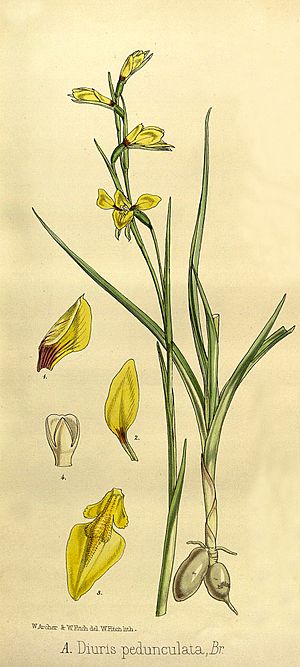Small snake orchid facts for kids
Quick facts for kids Small snake orchid |
|
|---|---|
 |
|
| Conservation status | |
| Scientific classification | |
| Genus: |
Diuris
|
| Species: |
pedunculata
|
| Synonyms | |
|
Diuris pallens Benth. |
|
The Diuris pedunculata, also known as the small snake orchid, is a special type of orchid that only grows in New South Wales, Australia. This means it is endemic to that area. It usually has two leaves near its base and one or two pretty yellow and orange flowers with purple patterns. This orchid used to be found in many places between Tenterfield and the Hawkesbury River. However, because it has lost much of its natural home, it is now mostly found only in the New England Tableland.
Contents
What Does the Small Snake Orchid Look Like?
The small snake orchid is a tuberous, perennial plant. This means it has a swollen underground stem (a tuber) that helps it store food, and it lives for more than two years. It grows as a herb with two straight, thin leaves that are about 4 to 12 centimeters (1.5 to 4.7 inches) long and 1 to 2 millimeters (0.04 to 0.08 inches) wide.
It usually has one or two pale yellow flowers with a bright orange labellum (the orchid's special lip petal). These flowers are about 1.5 to 2 centimeters (0.6 to 0.8 inches) wide and grow on a stem that is 6 to 18 centimeters (2.4 to 7.1 inches) tall.
Let's look closer at the flower parts:
- The top sepal (a leaf-like part that protects the bud) is shaped like a narrow egg, pointing upwards. It's about 7 to 10 millimeters (0.28 to 0.39 inches) long.
- The side sepals are long and narrow, about 1.5 to 2 centimeters (0.6 to 0.8 inches) long, and point downwards.
- The petals are narrow and oval-shaped, about 9 to 14 millimeters (0.35 to 0.55 inches) long. They spread out and hang down.
- The labellum (the lip petal) is about 1.4 to 1.6 centimeters (0.55 to 0.63 inches) long and has three parts, called lobes. The middle lobe is wide and egg-shaped, and the side lobes are small and triangular.
- There are also two small, bumpy ridges on the labellum that are 5 to 7 millimeters (0.2 to 0.28 inches) long.
This orchid usually blooms in August and September.
How the Small Snake Orchid Got Its Name
The small snake orchid, Diuris pedunculata, was first officially described in 1810 by a botanist named Robert Brown. He wrote about it in his book, Prodromus Florae Novae Hollandiae et Insulae Van Diemen.
The second part of its name, pedunculata, comes from a Latin word. It means "small, slender stalk," which likely refers to the orchid's delicate flower stem.
Where the Small Snake Orchid Lives
As mentioned, the small snake orchid used to be found in many scattered places across New South Wales, from Tenterfield down to the Hawkesbury River. Today, it is mostly found in areas around Armidale, Uralla, Guyra, and Ebor.
You can find this orchid growing in damp, grassy areas and in open forests.
Other similar orchids that grow in south-east New South Wales, the Australian Capital Territory, Victoria, and Tasmania are now considered a different species called Diuris subalpina.
How the Small Snake Orchid Reproduces
This orchid has a very interesting way of getting pollinated! It seems to use a trick called sexual deception. This means its flowers look and smell like female bees to attract male bees, mostly a native bee species called Halictus lanuginosus. The male bees try to mate with the flower, and in doing so, they help spread the orchid's pollen. Even though the flowers produce nectar and have a strong scent that attracts other insects, this "bee trick" is how it mostly gets pollinated.
Protecting the Small Snake Orchid
The small snake orchid, Diuris pedunculata, is in danger. It is listed as "endangered" by the Australian Government under the Environment Protection and Biodiversity Conservation Act 1999. It is also listed as endangered under the New South Wales Biodiversity Conservation Act 2016.
The biggest problems for this orchid include:
- Habitat loss: Its natural home is being destroyed or broken up into smaller pieces.
- Grazing and trampling: Farm animals walking on and eating the plants.
- Weed invasion: Other plants (weeds) taking over its space.
- Feral pigs: Wild pigs causing damage to the areas where it grows.
Protecting this special orchid is important so it doesn't disappear forever.


